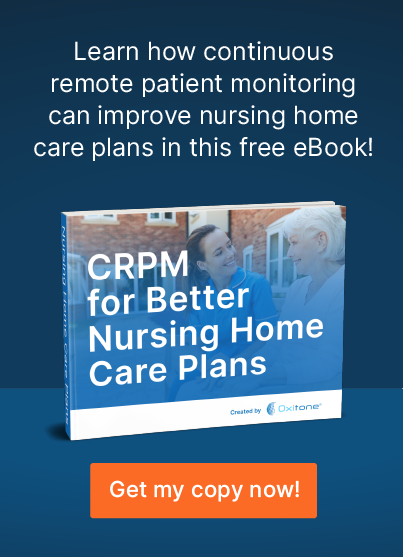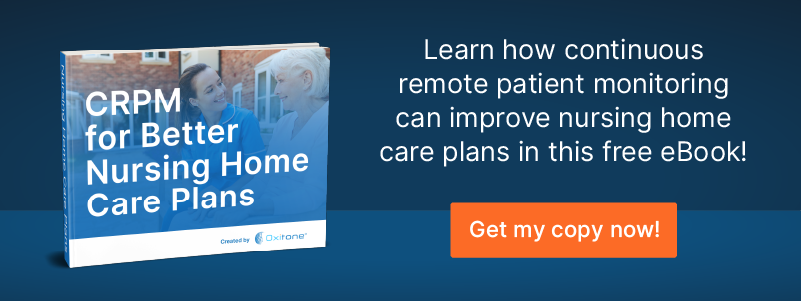As a doctor, you can’t be with your patients 24/7, especially not in the middle of a global pandemic. But since COVID-19 exacerbates preexisting conditions, remote monitoring of patients is more important than ever before.
Enter digital remote patient monitoring. Taking traditional patient monitoring to the digital sphere enables you to receive a constant flow of clinically relevant data about your patients’ symptoms and vital signs.
Chronic disease patients require a prompt response to medical emergencies, and as their doctor, you need an easy and timely way to follow up with them. Remote patient monitoring offers you that ability, but it is not without its limitations.
In this article, we explore the pros and cons of remote patient monitoring, with a particular focus on how continuous remote patient monitoring (CRPM) using wearable digital medical device technology solves the problems that accompany traditional remote patient monitoring.
Benefits of Remote Patient Monitoring
1. Improved Quality of Care
The top 5% of chronic disease patients account for 50% of annual care spending, costing the medical system approximately $50,000 per patient. Chronic disease patients also consume 80% of clinicians’ time, creating stress, anxiety, and frustration for both the doctor and the patient.
CRPM can improve the quality of care for chronic disease patients by providing you with a constant stream of patient data. Digital remote monitoring technology, like Oxitone, has a convenient notification system to inform you of critical changes in your patients’ well-being, allowing for greater continuity of care and freeing up more time to spend with your other patients.
The information loop between a patient and their doctor is of the utmost importance in providing continuous care for chronic diseases. Wearable digital medical device technology allows for enhanced patient-doctor communication and empowers patients to become active participants in their care.
2. Improved Quality of Life
Chronic disease patients have enough stress without needing to worry about exacerbations or emergencies. Remote patient monitoring improves patients’ quality of life by providing greater peace of mind, keeping them out of the hospital and preventing life-threatening events. Reducing patients’ stress load may have the added benefit of thwarting adverse health outcomes.
Traditional patient monitoring technology can be uncomfortable or inconvenient for patients. For example, Holter heart monitors are bulky and difficult to hide under clothing. The newest wearable digital medical device technology is more comfortable for patients than these traditional monitoring devices, making remote patient monitoring a breeze for both you and your patients.
3. Reduced Cost and Risks
Healthcare supply chain management is the second largest expense for healthcare providers, driving 45% of the non-labor budget. Remote patient monitoring can help your practice conserve resources (and stay safe from COVID-19) by reducing the need for in-person appointments and hospital stays and increasing the efficacy of treatment delivery.
Hospitalizations and emergency room visits come with lofty price tags for healthcare providers and patients alike. Remote patient monitoring reduces the need for hospital visits by detecting exacerbations of chronic conditions before they occur, allowing you to promptly prevent and treat life-threatening events.
Limitations of Remote Patient Monitoring
1. Patient Compliance
As a healthcare provider, you know that patient compliance is a significant obstacle to providing high-quality care. Traditional patient monitoring methods, such as pulse oximetry, rely heavily on self-report measures and patient compliance, which may not provide the most accurate estimates of patient data.
CRPM addresses this problem. Comfortable wearable medical device technology enhances patient compliance and provides you with a steady stream of quantitative data based on physiological measures, not self-reporting.
This objective data can be used to make better clinical decisions for patients. Rather than basing treatment plans on urgent medical events, you can use long-term measures of health data to more accurately and efficiently assess your patients’ needs.
2. Burden of Care
Traditional remote patient monitoring can create a burden for doctors and nurses, who must manually chart out the data reported by patients in order to draw significant conclusions. As busy healthcare providers, you and your staff don’t have time to record hundreds of patients’ needs by hand.
CRPM using wearable digital medical device technology reduces the labor burden on doctors and nurses by allowing you to check on thousands of patients with a single click. With one movement of your mouse, you can free up hours of time to provide better care to more patients.
Remote Patient Monitoring and Continuous Care
There are many diverse applications of continuous remote monitoring, but they all have one thing in common: they can make your (and your patients’) lives easier.
Continuous remote monitoring can be used to enhance patient care during home treatment of mild complications, the application of oxygen therapy, and post-acute event. During the rehabilitation process, it can reduce the need for in-person visits and hospital stays.
How Medical Devices Using Wearable Technology Improve Patient Care
One of the newest and most sophisticated developments in digital remote patient monitoring is the application of wearable medical device technology. These devices are as easy to use and as comfortable to wear as mainstream fitness trackers, yet they provide clinical-grade data on patients’ vital signs, activity, and more.
Wearables like Oxitone reduce the burden of care and enhance patient outcomes by increasing patient compliance with remote patient monitoring measures. Oxitone’s FlexSense elastic optical aperture provides both superior comfort and continuity of care, making it a win-win for both doctors and patients.
Oxitone supplies clinicians with a steady measure of baseline data like SpO2, pulse rate, HRV, activity, and sleep. However, it will only notify you when the data significantly differ from that patient’s unique baseline. Oxitone uses a smart five-step verification process before initiating an alert, to better protect your time away from the office.
In addition to ensuring that you are never unnecessarily disturbed at home, Oxitone can also help you better optimize your clinical time. You can monitor thousands of chronic disease patients with a single click, receiving accurate clinical data that does not depend on manual charting and freeing up more time for you and your staff to spend with other patients. Oxitone also comes with Bluetooth and API integration to reduce time spent entering patient data into your own platform for further analysis.
Here at Oxitone, we boost value-based healthcare by delivering extraordinary patient, clinical, and economical outcomes at reduced medical utilization and cost. Patients need a prompt response to emergencies. Physicians need an easy and timely follow-up with patients. Our mission is to transform chronic disease management and help save lives worldwide.
Let’s save lives together! To see how we help remote patient monitoring companies and physicians improve the management and care of high-risk patients, contact us today!


